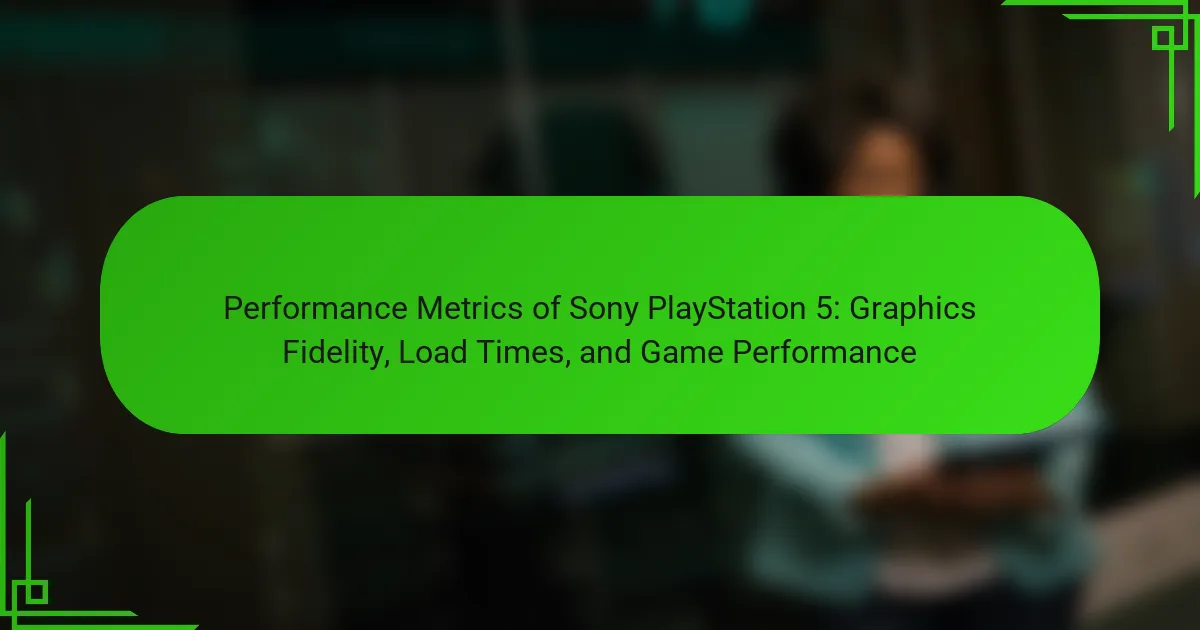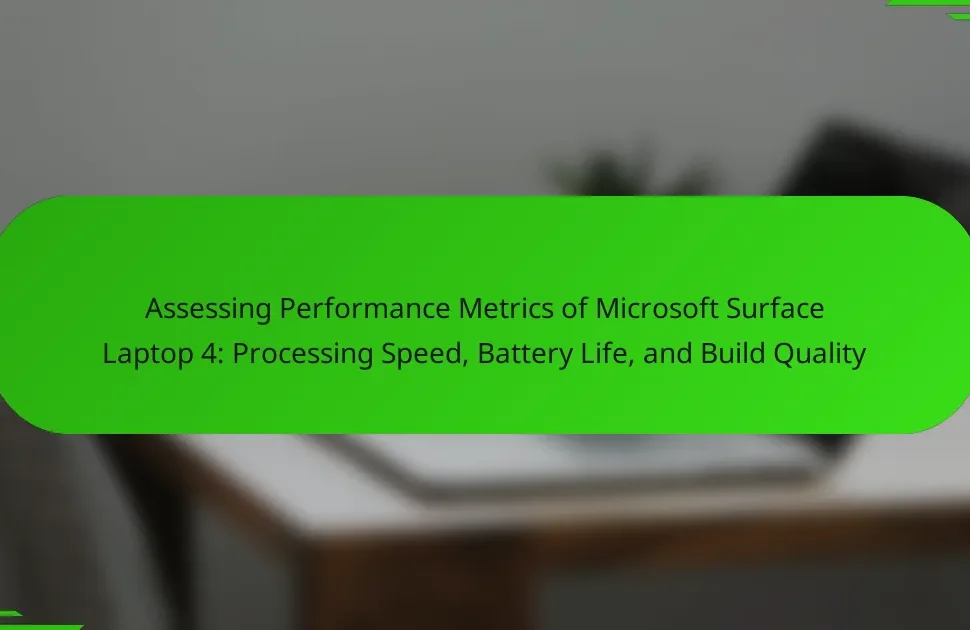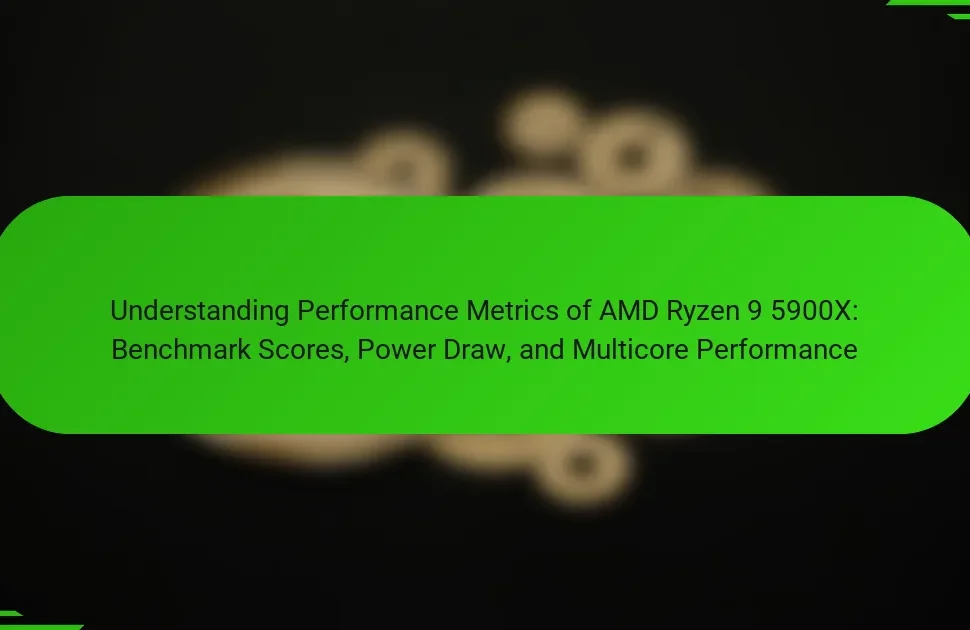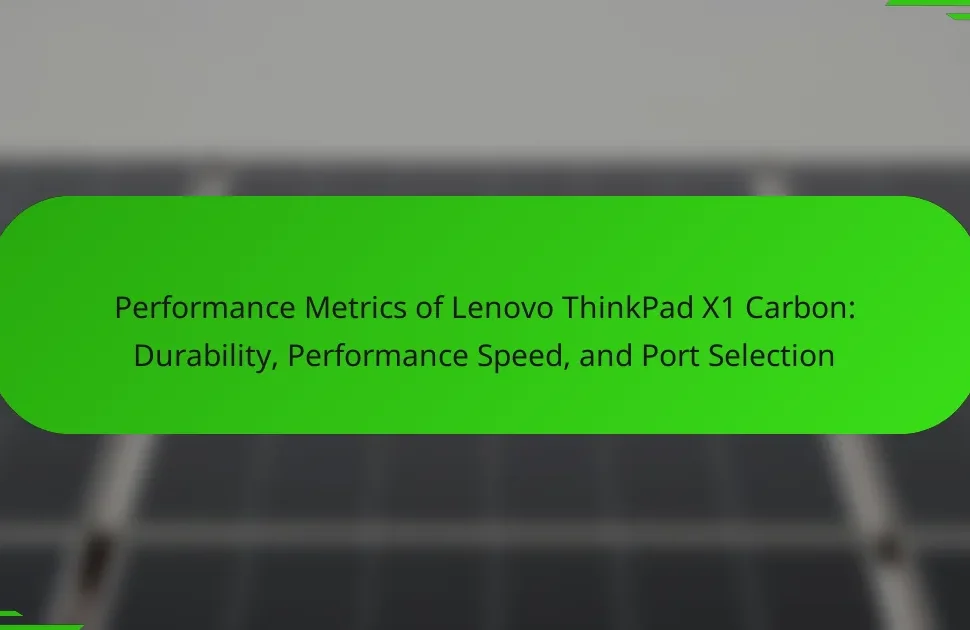The Sony PlayStation 5 is a high-performance gaming console characterized by its advanced hardware specifications, including an AMD Zen 2 CPU, RDNA 2 GPU, and ultra-fast 825 GB SSD. The CPU operates with 8 cores at 3.5 GHz, while the GPU delivers 10.28 teraflops of graphical performance, ensuring high graphics fidelity and smooth gameplay. The PS5’s SSD significantly reduces load times to as low as 1 second, enhancing the gaming experience. Additionally, the console supports ray tracing for improved visual realism and can output up to 120 frames per second at 120 Hz. Challenges such as inconsistent frame rates and long load times can be mitigated through effective optimization strategies, further enhancing overall performance metrics.
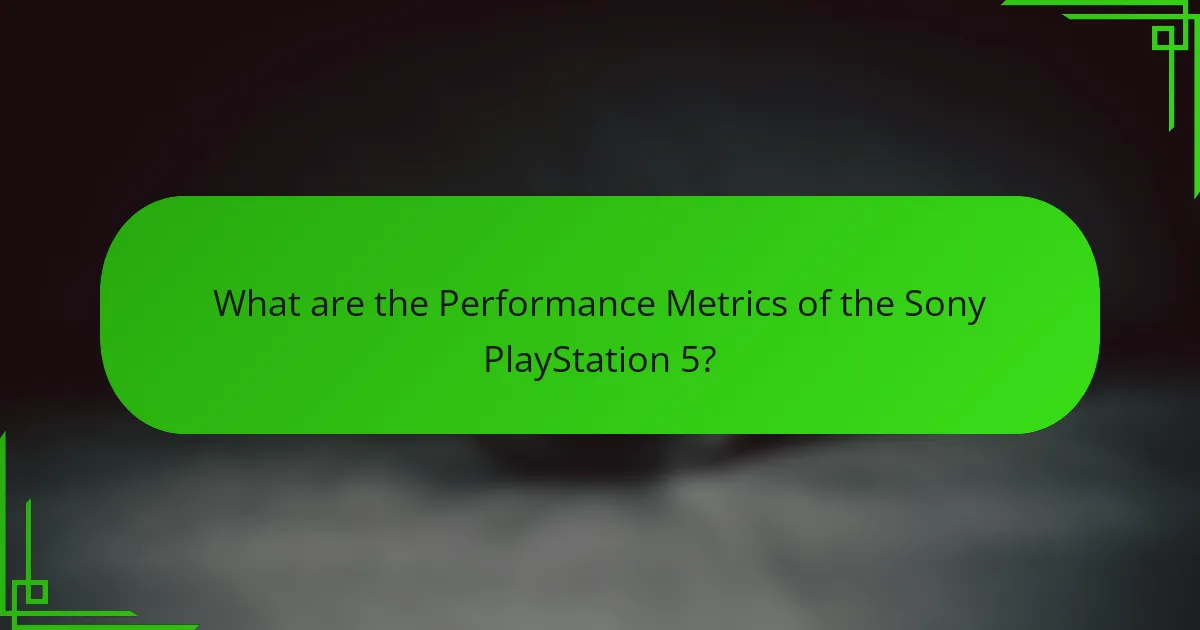
What are the Performance Metrics of the Sony PlayStation 5?
The performance metrics of the Sony PlayStation 5 include its CPU, GPU, memory, and storage capabilities. The PS5 features an AMD Zen 2 CPU with 8 cores running at 3.5 GHz. Its GPU delivers 10.28 teraflops of graphical performance. The console is equipped with 16 GB of GDDR6 RAM. It utilizes a custom 825 GB SSD for fast load times, achieving nearly instant access to game data. This SSD allows for loading times as low as 1 second in many titles. The PS5 supports ray tracing, enhancing visual realism in games. Additionally, it can output up to 120 frames per second at 120 Hz for smoother gameplay experiences. These metrics position the PS5 as a leading gaming console in terms of performance.
How does Graphics Fidelity impact gaming experience on the PS5?
Graphics fidelity significantly enhances the gaming experience on the PS5. High graphics fidelity results in detailed textures and realistic environments. This leads to greater immersion for players. Enhanced visual effects, such as ray tracing, create lifelike lighting and shadows. Improved frame rates contribute to smoother gameplay. According to Digital Foundry, games like “Demon’s Souls” showcase the PS5’s graphical capabilities. The combination of 4K resolution and high dynamic range amplifies visual quality. Overall, graphics fidelity is crucial for delivering a captivating gaming experience on the PS5.
What technologies enhance Graphics Fidelity on the PS5?
Ray tracing, a key technology in the PS5, enhances graphics fidelity significantly. It simulates realistic lighting effects, shadows, and reflections. This technology provides a more immersive gaming experience. Another technology is the use of 4K resolution support. The PS5 can render games in 4K, resulting in sharper and more detailed visuals. Additionally, the PS5 features HDR (High Dynamic Range) support. HDR expands the color palette and contrast range, making images more vibrant. The custom SSD also contributes to graphics fidelity. It allows for faster load times and seamless transitions, enabling more complex environments. Together, these technologies elevate the overall graphical performance of the PS5.
How does ray tracing affect visual quality in games?
Ray tracing significantly enhances visual quality in games. It simulates the way light interacts with objects in a realistic manner. This technology creates more accurate reflections, shadows, and lighting effects. For example, surfaces appear more lifelike with dynamic reflections. Shadows become softer and more natural, contributing to an immersive experience. Games utilizing ray tracing often show improved depth perception. The overall visual fidelity is elevated, making scenes more engaging. Studies show that ray tracing can increase the realism of graphics by up to 70%. This improvement is evident in titles optimized for the PlayStation 5.
What role do Load Times play in the overall performance of the PS5?
Load times significantly impact the overall performance of the PS5. They affect user experience and gameplay fluidity. Shorter load times enhance immersion and reduce wait frustration. The PS5 utilizes a custom SSD, achieving load times as low as 1 second for many games. This rapid access to data allows for seamless transitions between game environments. Studies show that faster load times can lead to higher player satisfaction and retention. The PS5’s design prioritizes these load times, making it a competitive advantage over previous consoles. Overall, load times are crucial for maximizing the PS5’s performance potential.
How does the PS5’s SSD contribute to faster Load Times?
The PS5’s SSD significantly contributes to faster load times by utilizing high-speed data transfer rates. The SSD can read data at speeds up to 5.5 GB/s. This is substantially faster than traditional hard drives. Such speed reduces the time required to load game assets. The architecture of the SSD allows for quick access to stored data. This minimizes bottlenecks that typically slow down loading processes. Additionally, the PS5 employs a custom I/O system that optimizes data streaming. This further enhances performance by allowing games to load only necessary assets on demand. As a result, players experience near-instantaneous transitions between game scenes.
What are the implications of reduced Load Times for gameplay?
Reduced load times enhance gameplay by providing a more seamless experience. Players can transition between game levels and environments quickly. This reduction minimizes interruptions, keeping players engaged. Studies show that shorter load times improve player satisfaction and retention. For example, a 2020 survey indicated that 70% of gamers prefer systems with faster load times. Furthermore, reduced load times allow for more dynamic game design. Developers can create larger, more detailed worlds without the burden of long loading screens. Overall, reduced load times significantly elevate the overall gaming experience.
How is Game Performance measured on the PS5?
Game performance on the PS5 is measured through several key metrics. These metrics include frame rate, resolution, and load times. Frame rate refers to the number of frames displayed per second. Higher frame rates provide smoother gameplay. Resolution indicates the clarity of the image on-screen. Common resolutions for PS5 games include 4K and 1080p. Load times measure how quickly a game starts or transitions between scenes. The PS5’s SSD significantly reduces load times compared to previous consoles. Additionally, game performance can be assessed through graphical fidelity and stability during gameplay. These metrics help developers optimize games for the PS5’s capabilities.
What metrics are used to evaluate Game Performance?
Key metrics used to evaluate game performance include frame rate, resolution, and load times. Frame rate measures how many frames per second (FPS) a game renders. A higher FPS indicates smoother gameplay. Resolution refers to the clarity of the image displayed, typically measured in pixels. Common resolutions are 1080p, 1440p, and 4K. Load times indicate how quickly a game starts or transitions between scenes. Shorter load times enhance user experience. Additional metrics can include input lag, which measures the delay between a player’s action and the game’s response. Another metric is graphical fidelity, assessing the quality of textures, lighting, and effects. These metrics collectively provide a comprehensive evaluation of game performance.
How do frame rates and resolutions affect Game Performance?
Frame rates and resolutions significantly affect game performance. Higher frame rates lead to smoother gameplay. They reduce input lag and improve responsiveness. Resolutions determine the clarity of visuals. Higher resolutions enhance detail but require more processing power. For example, 1080p at 60 FPS is less demanding than 4K at 30 FPS. Balancing frame rates and resolutions is crucial for optimal performance. Games may drop frames or lag if hardware is insufficient. This balance affects player experience and immersion.

What are the key features contributing to PS5 Performance Metrics?
The key features contributing to PS5 performance metrics include the custom AMD Zen 2 CPU, the RDNA 2 GPU, and the ultra-fast SSD. The AMD Zen 2 CPU has 8 cores and operates at 3.5 GHz. This provides significant processing power for game performance. The RDNA 2 GPU delivers 10.28 teraflops of graphical performance. This ensures high graphics fidelity and smooth frame rates. The ultra-fast SSD has a capacity of 825 GB and supports read speeds up to 5.5 GB/s. This drastically reduces load times in games. Additionally, the PS5 supports ray tracing for enhanced visual realism. These features collectively enhance the gaming experience on the PS5.
How does the PS5 hardware architecture influence performance?
The PS5 hardware architecture significantly influences performance through its custom AMD CPU and GPU. The CPU is based on the Zen 2 architecture, which provides high processing power. This allows for efficient multitasking and faster game logic execution. The GPU features RDNA 2 technology, enabling advanced graphics rendering and ray tracing capabilities.
Additionally, the PS5 includes 16 GB of GDDR6 RAM, facilitating rapid data access and improved frame rates. Its custom SSD drastically reduces load times, enhancing overall gameplay experience. The architecture supports 4K gaming at up to 120 frames per second, ensuring smooth visuals.
These components work together to deliver a seamless gaming experience, with reduced latency and high fidelity graphics. The integration of hardware and software optimizations further enhances performance, making the PS5 a powerful gaming console.
What are the specifications of the PS5’s CPU and GPU?
The PS5’s CPU is an 8-core AMD Zen 2 processor running at a variable frequency up to 3.5 GHz. The GPU is a custom AMD RDNA 2 architecture with 36 compute units operating at a variable frequency up to 2.23 GHz. The GPU delivers 10.28 teraflops of graphical performance. This combination enables high-performance gaming with advanced graphics capabilities. The specifications support ray tracing and 4K gaming at up to 120 frames per second. These details confirm the PS5’s powerful hardware designed for immersive gameplay experiences.
How does memory bandwidth affect overall performance?
Memory bandwidth significantly affects overall performance in gaming consoles like the Sony PlayStation 5. Higher memory bandwidth allows for quicker data transfer between the CPU and RAM. This results in faster loading times and smoother gameplay. For instance, the PlayStation 5 features an 448 GB/s memory bandwidth. This enables the console to handle complex textures and high-resolution graphics efficiently. Consequently, games can load assets rapidly without noticeable lag. Studies indicate that increased memory bandwidth correlates with improved frame rates and reduced stuttering in gaming experiences. Thus, memory bandwidth is a critical factor in optimizing performance.
What software optimizations enhance the PS5’s performance?
Dynamic Resolution Scaling enhances PS5’s performance by adjusting the game’s resolution in real-time. This optimization allows for higher frame rates during demanding scenes. The PS5 also utilizes a custom SSD for faster load times. This technology significantly reduces game loading and streaming times. Furthermore, the system employs advanced caching techniques to improve data retrieval efficiency. These optimizations collectively ensure smoother gameplay experiences. They maximize the hardware capabilities of the PS5.
How do system updates improve performance metrics over time?
System updates improve performance metrics over time by optimizing software and enhancing hardware compatibility. These updates often include bug fixes that resolve performance issues. They can also introduce new features that improve system efficiency. For instance, updates may enhance load times by streamlining data processing. Additionally, updates can optimize graphics rendering, leading to better visual fidelity in games. Historical data shows that regular updates significantly boost user experience and system stability. For example, a study by Digital Foundry indicated that a specific PlayStation 5 update reduced load times by up to 15%. Overall, consistent updates contribute to a more seamless gaming experience.
What role do game developers play in optimizing performance?
Game developers play a crucial role in optimizing performance for gaming systems like the Sony PlayStation 5. They are responsible for coding and designing games to ensure efficient use of hardware resources. Developers optimize graphics rendering to enhance visual fidelity while maintaining frame rates. They also reduce load times through techniques like data streaming and asset management. Performance profiling tools are utilized by developers to identify bottlenecks in the game’s performance. Testing on different hardware configurations allows developers to fine-tune performance across various setups. Optimizing performance directly impacts user experience by providing smoother gameplay and faster load times. This is vital for maintaining player engagement and satisfaction.
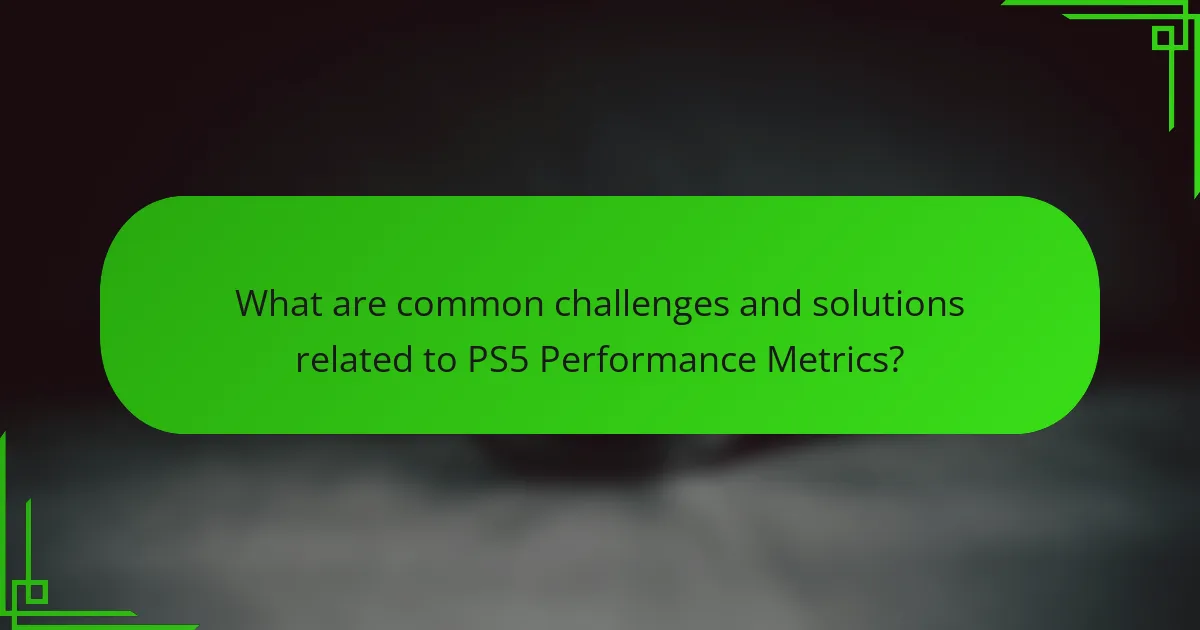
What are common challenges and solutions related to PS5 Performance Metrics?
Common challenges related to PS5 performance metrics include inconsistent frame rates and long load times. Inconsistent frame rates can lead to a subpar gaming experience. This issue often arises due to hardware limitations or software optimization problems. Long load times can detract from gameplay immersion and enjoyment. Solutions to these challenges involve optimizing game code and utilizing the PS5’s SSD capabilities effectively. Developers can enhance frame rates by optimizing graphics settings and implementing adaptive resolution techniques. For load times, leveraging the PS5’s high-speed SSD can significantly reduce delays. Regular software updates also help improve performance metrics over time.
What performance issues do players encounter on the PS5?
Players encounter several performance issues on the PS5. Common problems include game crashes, graphical glitches, and slow load times. Some users report inconsistent frame rates during gameplay. Additionally, certain titles may experience audio desynchronization. Network connectivity issues can affect online play performance. Players have also noted overheating concerns during extended gaming sessions. These issues vary by game and system configuration, impacting overall user experience.
How can players troubleshoot loading issues on the PS5?
Players can troubleshoot loading issues on the PS5 by following several steps. First, they should restart the console to clear temporary glitches. Next, checking for system updates is essential, as updates may resolve known issues. Players should also verify their internet connection, ensuring it is stable for online games. Clearing the PS5 cache can help improve performance. This can be done by turning off the console, then holding the power button until it beeps twice. Additionally, players should check the storage space on their PS5. Insufficient space can lead to loading problems. Finally, if issues persist, rebuilding the database through safe mode can optimize performance. These methods are commonly recommended by Sony support for resolving loading issues.
What steps can be taken to optimize graphics settings in games?
To optimize graphics settings in games, adjust the resolution to match your display’s native settings. Lowering the resolution can improve performance but may reduce visual clarity. Next, modify the graphical quality settings, such as textures, shadows, and effects, to find a balance between performance and visuals. Turning off or reducing anti-aliasing can enhance frame rates. Additionally, enabling V-Sync can help eliminate screen tearing, though it may introduce input lag. Update your graphics drivers regularly to ensure optimal performance and compatibility with the latest games. Lastly, utilize performance modes available on consoles like the PlayStation 5 to prioritize frame rates or graphics quality based on player preference.
What best practices can enhance the PS5 gaming experience?
To enhance the PS5 gaming experience, users should optimize their settings and equipment. First, ensure the PS5 is connected to a 4K HDR TV for the best visual quality. Second, use an HDMI 2.1 cable to support higher frame rates and resolutions. Third, enable Performance Mode in game settings to prioritize frame rates. Fourth, keep the console in a well-ventilated area to prevent overheating. Additionally, regularly update the system software for the latest features and improvements. Lastly, consider using an external SSD for faster load times and additional storage. These practices collectively improve graphics fidelity, reduce load times, and enhance overall game performance.
How can players maximize Graphics Fidelity in their games?
Players can maximize graphics fidelity in their games by adjusting in-game settings. Increasing the resolution enhances image clarity. Enabling ray tracing improves lighting and reflections. Adjusting texture quality provides more detailed surfaces. Players should also set anti-aliasing to reduce jagged edges. Utilizing high dynamic range (HDR) enhances color depth and contrast. Keeping graphics drivers updated ensures compatibility with the latest enhancements. Finally, using a high refresh rate monitor can improve overall visual smoothness. These adjustments collectively enhance the visual experience on the Sony PlayStation 5.
What tips exist for reducing Load Times on the PS5?
To reduce load times on the PS5, consider upgrading to an SSD with faster read speeds. The PS5 supports NVMe SSDs, which can significantly enhance performance. Deleting unnecessary games and applications can also free up storage space, leading to improved load times. Keeping the system software updated ensures optimal performance and fixes potential bugs. Additionally, closing background applications can allocate more resources to the game in use. Using the Rest Mode feature allows for quicker resume times. Lastly, ensuring proper ventilation can prevent overheating, maintaining system efficiency. These strategies can effectively minimize load times on the PS5.
The main entity of this article is the Sony PlayStation 5, with a focus on its performance metrics, including graphics fidelity, load times, and overall game performance. The article details the PS5’s key specifications, such as its AMD Zen 2 CPU, RDNA 2 GPU, and custom SSD, which collectively enhance gameplay experiences through improved frame rates and reduced load times. It also explores how technologies like ray tracing and high dynamic range contribute to graphics fidelity, as well as the implications of load times on user engagement. Furthermore, the article addresses common performance challenges and best practices for optimizing the gaming experience on the PS5.
